FINDINGS AND RECOMMENDATIONS
I. FORECASTING METHODS
The INS did not document and preserve an adequate record of
forecasting actions which, in retrospect, could have provided a
better understanding of procedures used and their effectiveness.
There was no evidence that current or previous forecasting
methods had been validated. The INS budget analysts were not
trained to develop statistical forecasts. Revenue forecasts
should be made using accrual accounting, but some fee account
projections were made and analyzed on a cash basis, and others on
a modified accrual basis. As a result, responsible staff did not
have all the accounting and program information to better support
resource allocations, budget reprogrammings and justifications.
Data used to develop budgets may be inaccurate, but we cannot
determine the reliability of the data until INS has a credible
accounting system.
Fee revenue collections comprise approximately one-third of
the INS' total budgetary authority. The Department of Justice
(DOJ) guidance issued in the User Fee Programs (Supplement to the
DOJ Budget Formulation and Execution Calls) prepared by the
Controller, Justice Management Division (JMD) in April 1993,
states that:
"Fee account budgets shall be prepared annually . . . .
Forecasts shall be predicated on anticipated workloads, fee based
revenues, and accrued expenditures in accordance with OMB
Circular No. A-11, Preparation and Submission of Budget Estimates
. . . revenues shall be presented on an accrual basis."
Under an accrual method, revenues are recognized when earned
and expenses are recognized when a liability is incurred, without
regard to the actual receipt or payment of cash. This provides a
better matching of revenue with expenses and enhances the ability
to set fees appropriately to recover the full costs of providing
a public service.
To calculate the total budgetary resources available for INS
use, its Budget Division combines the amount of funds
appropriated from Congress with unobligated fund balances from
the prior year, and an estimate of revenue for the upcoming year.
A variety of methods are used to prepare fee revenue estimates.
The specific approaches taken to estimate each fee account's
revenue are discussed briefly below:
User Fee. The INS projected User Fee collections based
on fees remitted by domestic and foreign carriers in prior
periods. Carrier collections were entered into an electronic
spreadsheet and the total collected was adjusted upward or
downward by an amount estimated to reflect trends in
international travel patterns.
Examinations Fee. The INS used a statistical model to
project the number of applications and petitions which would be
submitted during the budget year. This regression model, which
calculates numerical links between multiple variables, was
developed using approximately 3 years of historical data. The
projected numbers of applications were then multiplied by the
amount of fee charged per application, and then reduced by
applying an anticipated non-collection rate for some of the
application types. When appropriate, estimates were then adjusted
to reflect the current trends and global influences. Adjustments
were suggested and applied by a working group consisting of a
number of internal INS experts.
Legalization Fee. This program was expected to be
phased out and collections had been dwindling. To minimize the
amount of resources expended in developing estimates, the last
available year's collections were reduced by a percentage which
was determined after discussions with legal counsel.
Land Border Fee. The INS estimated revenue of $1
million per site per year, without refining estimates by
location, activity, traffic patterns, or adjustments to projected
site openings. Because projected sites were delayed in opening,
revenue was much lower than anticipated each year since program
inception. Beginning in FY 1994, INS adjusted revenue estimates
due to the revised site opening schedule.
Additional detail on the methodology and accuracy of each of
these four methods will be discussed in the section immediately
after this overall forecast discussion.
The INS' Budget Division was organized to identify resources
needed, develop resource allocation plans and monitor incomes and
outflows. General duties were stipulated in the INS Budget
Division's mission statement and restructuring plan for each of
the different branches. For three Budget Division branches
involved in Fees Forecasting, the stated missions were:
· The Analysis and Formulation Branch managed the process for
the development and presentation of the budget and worked with
programs, operations, and policy and planning to develop
meaningful measurement criteria.
· The Execution Branch was tasked with tracking current year
resources and monitoring budgetary information for INS automated
systems.
· The Fee Policy and Rate Setting Branch was charged with
reviewing and developing rate schedules, to ensure revenues are
sufficient to cover all costs, and ensuring that procedures are
in place for monitoring costs of fee activities.
For an additional discussion on INS' Budget Division see
Appendix II.
In the 1994 DOJ Report by the Attorney General on Management
Controls, Fee Account Management was designated a High Risk
Area/Material Nonconformance. This report stated:
"INS has not put in place the staff, systems, and
procedures to ensure that the fees collected are accounted for,
properly controlled, and deposited promptly."
On a monthly basis, INS' Accounting Operations and Reports
Analysis Branch prepared a Status of Funds Report that summarized
for each fee account the bank deposits made, obligations
incurred, and the unobligated balance. This report was used to
compare actual receipts to estimated collections for the User
Fees, and less regularly for the Examinations Fees. In our
judgment, the actual number of inspections performed, as reported
in INS' Performance Analysis System could also be used regularly
to compare the amount of services rendered with the amount of
fees collected.
Training in statistical techniques and forecasts was not
provided to INS budget analysts. Automated computer depictions
and alternative scenario comparisons were not readily available
or encouraged. As part of this audit, we explored various options
to automate and enhance forecast methodology, such as using
different databases, electronic spreadsheet packages, and
specialized statistical forecasting software. There has been
rapid development of computer tools and software along these
lines recently.
We invited INS officials to attend a demonstration of the
capabilities of a computer statistical package that we reviewed.
We believe that this program could provide a relatively
inexpensive automated system to enable INS to create, maintain,
and evaluate an historical database. Some INS officials that
attended the software demonstration agreed with the need to move
forward with the purchase of this or a similar tool. INS could
reassign or detail in-house experts from other offices, such as
the Statistical Analysis Branch , to develop necessary
specialized tools and approaches for its Budget Division. Using
such a specialized computer forecasting package has the advantage
of demonstrating anticipated effects or impacts under different
scenarios, from a legislative change, to an international crisis,
or a simple fee adjustment. Some disadvantages of specialized
tools would be the training expense and a greater reliance on
those with this special training. As an alternative to developing
in-house expertise for the User Fee and Land Border Fee from
among the available staff, the INS might consider using an
outside source to develop revenue projections.
Overall Effectiveness
Annual fee account receipts have been somewhat unpredictable
in total. The total annual fee collections ranged from $390
million in FY 1991 to $532 million in FY 1994. However, INS
estimated annual User Fee revenue within approximately 10 percent
of actual receipts from FY 1992 to FY 1994. Occasionally, when
there was a significant disparity between forecast and actual
collection activity, the Budget Division was asked by INS
management or Congress to describe the estimating technique used.
There was no evidence that staff compared alternative forecasting
techniques or evaluated the quality of information used or
rejected, other than these occasional briefings. The only regular
documentation of forecast effectiveness was in INS' budget
submissions and reprogramming memoranda.
As mentioned previously, Fee Account Management was designated
a High Risk Area/Material Nonconformance in the 1994 DOJ Report
by the Attorney General on Management Controls. In this report,
INS determined that an appropriate corrective action would be to
develop and implement revenue forecasting models and validate
those revenue forecasting methodologies for each fee account. Our
review disclosed no documented evidence of validation efforts for
forecasting methodologies used by the Budget Division.
We believe that INS should document its revenue forecasting
procedures and periodically validate their effectiveness through
a comparison of results with estimates. Reasons for differences
should be determined and documented as part of this validation
effort. Staff should perform post-analyses to fine-tune each
forecast method, document what actual data were used, and why
other sources of information might have been rejected.
INS should continually explore other sources of information
which might become available for use and analysis. During
interviews with Customs staff, we learned of an automated system
at U.S. ports of entry developed by Customs to track inspection
activity. Discussions with INS staff indicated that they were
aware of the Customs database, however, INS considered its own
information to be sufficient.
Fee account activity results from complex international issues
requiring specialized knowledge and sophisticated modeling
techniques to predict. INS has recently created a working group
to develop Examinations Fee forecasts. Working groups combine the
knowledge and judgment of budget, program, and statistical
personnel among others, to explore circumstances, spark
discussions, and highlight events that otherwise might not be
considered. The use of the working group is an excellent idea
that should be expanded to the other fee accounts. The result of
this collaborative technique is the ability to react quickly and
effectively. Such an approach would be nearly impossible to
translate to a computer simulation or model. Therefore, we
suggest that working groups or teams be established for each fee
account and used to refine estimates, regardless of what initial
method is used.
In our judgment, the Budget Division should develop a
consolidated monthly status report for all fee accounts to
highlight the status of any new or proposed fees, legislative
changes, or a shifting of the Agency's priorities. This monthly
status report should be used to periodically brief INS senior
management, prepare budget documents, and assist working groups
in their forecast assessments. The use of such a briefing
document should naturally foster an analysis of trends and
reasons for changes, thus enhancing INS' ability to forecast for
the future. Significant variances between forecasts and actual
collections, including probable causes for such variances, should
be discussed and attempts made to improve forecasting techniques.
RECOMMENDATIONS
We recommend that the INS Commissioner:
1. Use an accrual method to prepare all fee revenue forecasts,
then document and validate each method, at least annually.
Immigration and Naturalization Service Comments
INS agrees. Currently, INS accrues revenues on a monthly basis
and estimates for Immigration User Fees are made on both an
accrual and cash basis. Accruals have been based on collections;
however, future accruals are to be based upon inspections
workload statistics. It should be noted that in order for INS to
move to an accrual basis for this account, INS financial systems
must be capable of establishing revenue and expense accruals in
order for the status of the account to be accurately displayed.
Until that time, the account must continue to be managed and
controlled for budgetary purposes on both an accrual and cash
basis. The INS will formally document each estimating method and
will validate each method by evaluation and comparison with
actual results.
Status of Recommendation
Resolved, based on the INS determination that User Fee revenue
forecasts should be prepared on an accrual basis using inspection
workload statistics. To close this recommendation, please provide
us with a description of the methodology to be used to determine
reasonable accruals for each fee account, along with copies of
any implementing memoranda. In addition, please provide a copy of
the first annual documentation and validation for each fee
account.
2. Explore other statistical analysis methods, such as
commercial computer software packages that were developed
specifically for forecasting workload activity to project
revenue.
Immigration and Naturalization Service Comments
INS agrees. INS has recognized that fee forecasting is an area
where there can be continuous improvement. Over the past 3 years,
INS has made strides in improving fee forecasting methodology and
will continue this effort. It should be noted that regardless of
the statistical software package used, it is not always possible
to assume constancy of data over time since immigration history
is laden with unpredictable political and policy decisions that
impact data and estimates. However, INS will consider commercial
statistical software packages which are currently available, and
any new software as it becomes available, in the effort to
enhance revenue forecasting.
Status of Recommendation
Resolved, based on INS' intention to consider commercial
statistical software packages in its effort to enhance revenue
forecasting. To close this recommendation, please provide us with
the results of your consideration of software packages.
3. Expand the use of working groups or teams to each fee
account and collect and distribute working group minutes.
Immigration and Naturalization Service Comments
INS agrees. The establishment of the working group for the
Examinations Fee Account's revenue forecasting has proven to be a
useful tool. Recognizing this, a working group for the User Fee
was established and the first meeting was held on January 25,
1996. We will continue to hold these meetings regularly. In
addition, a working group will be established for the Land Border
Fee Account. Formal working group meeting minutes will document
each session. The meeting minutes will be distributed to working
group members and appropriate management officials on a timely
basis.
Status of Recommendation
Closed, based on INS' establishment of a working group for
User Fees.
4. Develop a quarterly report on fee account activity that
highlights trends, comparisons, evaluations, and available fund
balances.
Immigration and Naturalization Service Comments
INS agrees. A report similar to the one recommended
highlighting these issues for fee revenues has been prepared and
used in every INS financial review at the end of each quarter.
These reports will be prepared and issued on a regular basis, and
they will be expanded to include additional information including
data on revenue trends.
Status of Recommendation
Resolved, based on the agreement that INS will augment
existing quarterly reports to include information on trend
comparisons, evaluations, and available fund balances. To close
this recommendation, please provide us with a copy of a regular
quarterly report issued that includes the expanded information.
USER FEE FORECAST
Because INS used an analysis of actual cash collections and
deposits, User Fee activity was evaluated on a cash basis, not by
using an accrual method. Carriers are required to submit their
fee collections to INS on a quarterly basis. Bank deposits of
these collections usually lag well behind actual passenger travel
dates; in some cases, fees were not deposited until 3 to 6 months
after passengers paid their fees. INS used carrier payment trends
to estimate revenue earned. As a result, INS was not complying
with DOJ budget requirements to use accrual methods in estimating
budget revenue. This could also significantly diminish INS'
ability to timely detect changes in international travel
patterns, should such a change occur, and thereby reduce their
ability to accurately forecast fee revenue.
The Immigration User Fee Account was established in 1986 by
the Omnibus Appropriation Bill, P.L. 99-591. Individuals
traveling into the United States on commercial aircraft or
commercial vessels are charged for inspection services performed
at air and sea ports of entry or for preinspection services
performed at certain places outside of the United States. Sea
passengers arriving in the United States from Canada, Mexico and
the Caribbean are exempt from paying the User Fee. Prior to
December 1994, the fee was $5 per individual, currently the fee
is $6 per individual.
The INS does not directly collect fees from passengers. Air
and sea carriers, travel agents, tour wholesalers, or other
entities who issue tickets collect the fees from nonexempt
passengers, and remit fees to INS through specified banks on a
quarterly basis. Because carriers do not always itemize
submissions to INS, but may simply provide totals, User Fee
revenue may include an unidentified portion of interest that
properly should be sent to the Treasury.
The INS estimates of future User Fee collections were
calculated by entering prior period deposit information into a
spreadsheet to determine a trend line. Trends were adjusted
either upward or downward as appropriate for expected variations
in international traffic. In addition, the Status of Funds Report
prepared by INS' accounting section was also used to evaluate
cash deposits from carriers. Beginning in FY 1996, a monthly
collection report from carriers was used to supplement available
information on User Fee receipts. Carriers who receive more than
$50,000 in User Fees in any month, other than one of the four
payment months, are required to report the amount received to
INS. This monthly reporting requirement was intended to provide
more timely information on actual User Fee collections so that
INS management can respond more efficiently to unforeseen
occurrences. The FY 1995 and FY 1996 receipt estimates were
determined using the FY 1994 collections as the base and adding
an expected international passenger traffic increase of 6.6
percent per year. This expected increase was determined through
an average of industry expectations reported in several
commercial and governmental publications. The User Fee
forecasting approach has remained substantially unchanged for the
last several years.
Forecasting Effectiveness
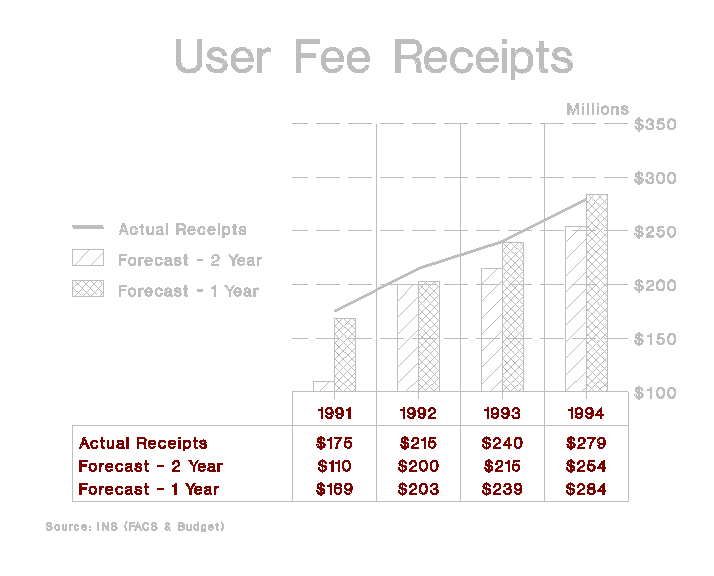
The 2 year revenue forecast has been within ten percent of actual
receipts for the last 3 years. The 2 year revenue forecast for FY
1991 was under forecast by $65 million, due primarily to an
unanticipated change in the classification of passengers to be
charged fees. The 1 year forecast was within six percent for the
last 4 years. The following chart depicts actual User Fee revenue
collections compared to INS' 1 year and 2 year forecasts.
To compare User Fee collections to other sources of
information, we contacted several other federal agencies that are
involved in international travel. This included the U.S. Customs
Service and the Department of Transportation (DOT). The DOT
receives current information directly from the carriers on the
number of international flights into the United States and the
number of passengers on each flight. DOT information is available
on a monthly basis and in a variety of formats. This information
includes a database with individual fields encoded in standard
format. We requested and received the DOT database of
international flights from calendar years 1991 to 1994.
We reviewed the monthly information from the DOT International
Form 41 on the arrival of passengers from foreign ports into the
United States, from calendar years 1991 to 1994. The Directory of
Transportation Data Sources listed this database as the
"T-100 International Markets (Data Bank 28IM)
Database." The chart below displays the number of passengers
arriving at U.S. ports of entry on a monthly basis from FY 1992
to December 1994, the end of our test period. (For this chart, FY
1992 includes June 1991 through May 1992, FY 1993 includes June
1992 through May 1993, etc.) The resulting plot demonstrates that
the traffic data has a discernible seasonal variation and a
small, but evident, increase each year during our review period.
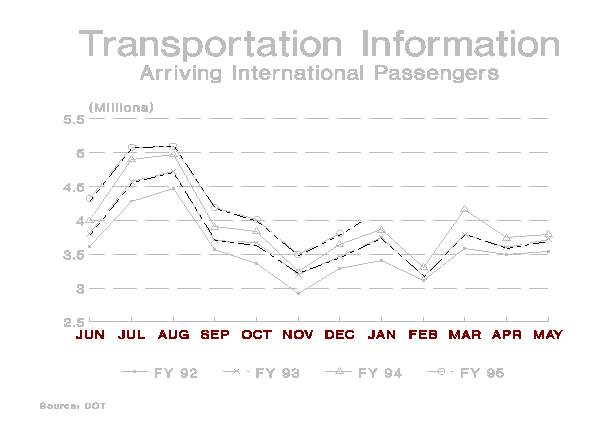
Although a small percentage of international passengers arriving
in the United States are exempt from paying the User Fee, we
assumed the quarterly and annual effect of these exemptions would
be immaterial and did not attempt to adjust for this small
amount. We multiplied $5 times the number of arriving passengers
per month [ Individuals traveling into the United States were
charged $5 prior to December 1994. User Fee was increased to $6
per person after December 1994.] to get an approximation of
accrued revenue for each month. We combined these monthly accrual
figures into quarterly accruals and assumed that they would not
be deposited until 3 months later. We called these quarterly
estimates "Anticipated Revenue." The next chart
compares quarterly anticipated revenue to actual quarterly User
Fee collections.
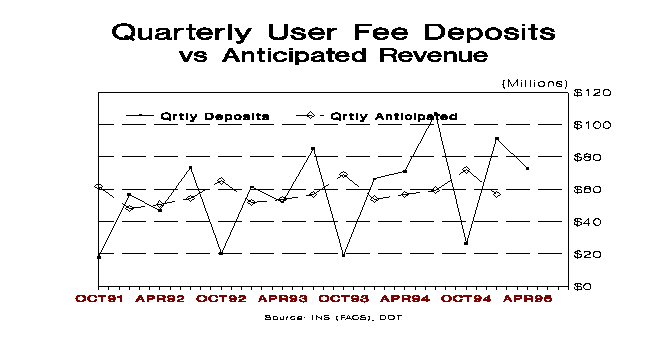
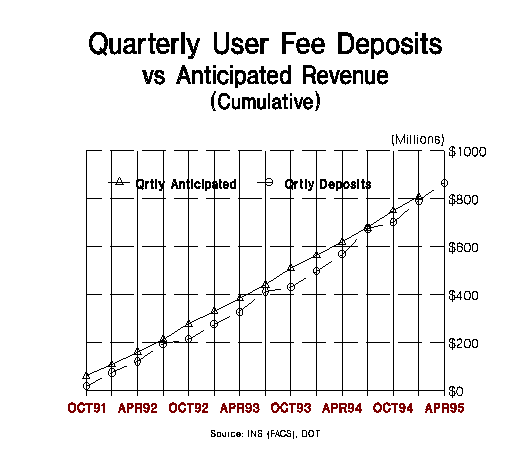
The two plots vary during most quarters, but the size of the
variations appear somewhat similar. To determine the relationship
of the total amounts, we then plotted both sets of data using a
cumulative approach.
The adjacent chart demonstrates that towards the end of our
review period the total anticipated revenue equals the total
actual deposits.
The totals in the DOT T-100 database of international
travelers would appear to compare favorably with the totals in
the carrier collections. Using the DOT T-100 data to predict
revenue on a cumulative basis could possibly give INS better
timeliness and accuracy on a annual basis, but this type of
analysis might be even more valuable on a quarterly basis.
Analysts could project the amount of revenue that will be
submitted by the carriers one quarter in advance, and this
process could provide a better estimate of accrued revenue,
particularly for the end of the year financial close-outs.
Although INS has had the most success in forecasting User Fee
revenue, there are other methods and sources of information that
could be used to improve it even further. We suggest that
information, such as the DOT database, could be used to predict
revenue more accurately based on our comparison over a 4 year
period. Advantages of the DOT database are timeliness,
standardized format of data, and the flexibility of use for
analysis. It is relatively easy to sort and analyze these numbers
by global travel trends, seasonal and annual variations, or U.S.
ports of entry. This information would also give INS some
assurance that the amount of receipts collected is reasonable
based on the total number of arriving passengers. It would also
provide a better indication of accrued revenue for the end of the
year close-out and the financial statements.
Periodic carrier audits are performed by the INS to determine
if collection submissions are reasonably accurate and timely.
Customs also performs periodic carrier audits. A Memorandum of
Understanding between Customs and INS to share the responsibility
for auditing carriers, share relevant information, and to compare
carrier fee submissions between the two agencies, was suggested
and drafted. We believe that INS should proceed with this
agreement and continue to explore other sources of information
for comparisons and reassurance.
RECOMMENDATION
We recommend that the INS Commissioner:
5. Use the DOT T-100 monthly data to analyze passenger traffic
and accrued revenue on a cumulative basis. The data could be used
by the working group to assist in predicting the revenue and as
auxiliary evidence to validate User Fee forecast method.
Immigration and Naturalization Service Comments
INS agrees that this data could prove to be a useful tool, but
it is not the only tool which should be analyzed and evaluated.
The T-100 data does not provide information related to fee
exemptions. INS' own Performance Analysis System for inspection
data will be used in conjunction with the DOT T-100 data. INS
will begin to use the T-100 data cumulatively in analyzing User
Fee revenues.
Status of Recommendation
Resolved, based on the agreement that INS will utilize the DOT
T-100 data cumulatively in analyzing User Fee revenues. To close
this recommendation, please provide us with examples of ways INS
is using the T-100 data in its analysis of User Fee revenues.
EXAMINATIONS FEE FORECAST
Examinations Fee forecasts were developed using a computer
model that compared and averaged the submission activity of 45
fee-related applications and petitions. A working group analyzed
and adjusted the results of the computer forecast, when
appropriate. Although working group meeting minutes were usually
prepared, they were not always done timely or in enough detail
for members to recall, after a period of time, why forecast
numbers were changed.
The Examinations Fee or Immigration Examinations Fee Account
was established by the DOJ Appropriations Act, 1989, P.L.
100-459. All deposits to the Examinations Fee are available until
expended to reimburse the appropriated account for expenses
incurred in providing immigration, adjudication, and
naturalization services. Applications for immigration,
nationality and citizenship benefits, and naturalization are
received and adjudicated at service centers, field offices,
numerous sub-offices, and some land border ports of entry.
Applications were submitted by mail or in person at field offices
or service centers. Receipts were collected by INS employees and
contract employees and deposited to banks, usually on a daily
basis.
First attempts to develop a forecast model for the
Examinations Fee included the creation of a spreadsheet to track
the amount of application fees collected. The number of
applications submitted and other workload information was
extracted monthly from the Performance Analysis System. [ An
audit of the Performance Analysis System was beyond the scope of
our audit, therefore we did not verify the accuracy of the
information contained in this system. However, nothing came to
our attention which indicated the data were inaccurate. ] A
simple graphic plot and analysis was used to estimate workload
trends and associated revenue. The Performance Analysis System
was also used to evaluate the backlog of applications to assist
in managing resources. After an initial evaluation of the
spreadsheet forecast, INS confirmed that a more sophisticated
approach was necessary.
In April 1994, INS' Statistical Analysis Branch developed a
statistical forecast (regression) model to project the number of
applications and petitions that would be submitted on an annual
basis. FY 1995 was the first full budget year this model was used
to project collections for the Examinations Fee. This projection
was based on activity in 45 fee-related applications and
petitions, five of which currently charge no fee, with two
additional lines reserved for future use. When developing the
computer forecast model, analysts noted that in some months
activity varied dramatically. To lessen the impact of a single
month's variation, the Statistical Analysis Branch eliminated
extreme variations and one-time events in the pattern by
replacing some of these numbers with averages. From this modified
database, the model produced an annual activity projection for
each of the 45 line items. Estimated annual Examinations Fee
revenue was calculated by multiplying fees charged per
application, by an anticipated collection rate. These collection
rates range from 40 percent to 100 percent and were also based on
historical behavior; some application fees are not collected due
to exemptions, waivers, returned checks, or other circumstances.
Annual revenue estimates are then divided into monthly revenue
estimates.
The working group periodically compared actual numbers of
applications submitted to INS, as reported in INS' Performance
Analysis System, to forecast activity. In FY 1993 and FY 1994,
INS received 4.5 million and 4.2 million applications
respectively for various immigration services and benefits.
Receipts for the Examinations Fee totaled $267.6 million in FY
1994, a 2 percent decrease from the $274 million for FY 1993.
This decrease was attributed to decreasing application activity.
Forecast Effectiveness
The best and the worst Examinations Fee forecasts noted during
our review period occurred in FY 1991. The following chart
depicts the actual Examinations Fee revenue compared to INS' 1
and 2 year forecasts.
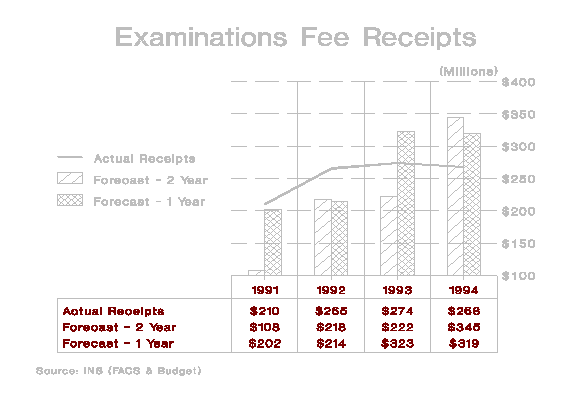
The 2 year revenue forecast was underestimated by approximately
$102 million, due to a substantial change in rates that was
unanticipated for the 2 year forecast, but the 1 year forecast
was underestimated by only $8 million. INS under forecast revenue
from FY 1991 to FY 1993. Then, the 1 year forecast for FY 1993
was over forecast by about 18 percent, and the FY 1994 estimates
exceeded actual revenue by an average of about 24 percent.
Because Examinations Fee revenue forecasts remained imprecise,
INS began using a working group approach in April 1994. The
statistical model and the working group process was used to
adjust the 1 year Examinations Fee forecast for FY 1995. However,
since the FY 1995 actual figures were not available when this
report was prepared, it is too soon to comment on the
effectiveness of the statistical model and the working group.
The Examinations Fee working group was organized to review,
analyze, and refine each line of the computerized forecast
output. The members of the working group were selected because of
their expertise in current legislative affairs, statistics,
demographics, and other key disciplines. The combined knowledge
and judgment of budget, program, and statistical personnel among
others, was pooled to explore circumstances, spark discussions,
and highlight events that otherwise might not have been
considered. The result of this collaboration is the ability to
react quickly and effectively in a variety of circumstances. We
believe the working group process would be nearly impossible to
translate to a computer model. The use of the working group was
an excellent idea that should be expanded to the other fee
accounts. Therefore, we suggest that working groups or teams be
established for the other fee accounts and used to refine
estimates, regardless of the initial method used. However,
working group minutes must be documented timely and in enough
detail for working group members to recall why adjustments were
made.
Staff should validate this methodology and regularly perform
post-analyses to refine the forecast method. Excessive reworking
and averaging of data used in producing forecasts should be
avoided since this could diminish objectivity and possibly impact
reliability. Although Examinations Fee receipts were compared to
anticipated receipts on occasion, in our judgment, these
comparisons and explanations should be prepared and distributed
on a regular basis, perhaps monthly.
Fee account activity and forecast results should be recorded
and used to further refine the estimation process. INS staff
should be encouraged to continually explore alternative
approaches. We suggest that INS management investigate other
statistical analysis methods, such as, commercial software
packages that are developed specifically for forecasting revenue.
One such commercial package that was demonstrated for this audit
and presented to INS representatives is available through
Government approved sources.
LEGALIZATION FEE FORECAST
Based on the requirement to maintain an appeals unit through
calendar year 1996, INS estimated that Legalization Fee
collections would only be sufficient to meet minimum funding
needs. The Legalization Fee Program was expected to be phased out
and fee collections have been dwindling. Several class action
suits relating to the Legalization Program are pending final
resolution in the courts. Depending on the outcome, the
resolutions could generate additional processing, but since the
outcome is unknown, no additional resources are being requested.
As a result, the Budget Division sought to minimize the amount of
resources expended in monitoring this program. There was no
documentation of methods used to produce a forecast.
The Immigration Legalization Fee Account was established in
November 1986 by the Immigration Reform and Control Act of 1986,
P.L. 99-603. The Act authorized the INS to charge fees in
connection with the filing of applications for the adjustment of
status and to deposit these fees into a separate account. The Act
was intended to grant amnesty to certain aliens who entered the
United States illegally or lapsed into illegal status prior to
January 1, 1982, and who have resided in the United States since
then and who are not excludable. These persons could apply for
temporary resident status. The law allows those granted temporary
resident status to apply for permanent resident status after 18
months upon showing general admissibility and citizenship skills.
Applicants submit applications by mail to an INS service center.
Receipts were collected and totaled by INS employees and sent to
banks on a regular basis.
During 1990, the Legalization Regional Processing Facilities
were merged with the INS service centers. INS management
completed the majority of applications for permanent resident
status during 1991. The 1992 DOJ Appropriations Act provided up
to $3 million per year of the unobligated balances remaining in
the Legalization account to the Office of Special Counsel for
Immigration Related Unfair Employment Practices. All of the 107
legalization offices were closed by the end of 1993, except for
the Los Angeles and Manhattan offices. INS estimated that
additional filing fee receipts from court mandated actions would
cover any additional costs incurred. During FY 1993,
approximately 500 to 1,000 of the weekly applications for class
membership were accepted as prima facie eligible. The results of
a class action suit could cause the reopening of the Legalization
Program. The outcome was unpredictable at the time this report
was prepared and it is not possible to estimate the number of
applications which may be submitted depending on the Court's
decision. Resources in the Adjudications and Naturalization
Program field offices will be used to process and adjudicate
applications of class members to the litigation and all remaining
applications for adjustment under the Legalization Program. As of
the beginning of FY 1995, there were over 7,000 appeals pending,
which consisted of appeals to the denial of applications for
temporary residence,termination of temporary residence, and
denial of status adjustment to permanent residence.
To estimate future revenue, recent application collection
trends are decreased by about 50 to 75 percent, based on
expectations from INS legal counsel after assessing recent
events, estimates from the adjudication programmer, and the
status of legal actions.
Forecast Effectiveness
Since the program extended beyond expectations, actual
receipts consistently exceeded forecast revenue during most of
our audit period. The following chart compares actual revenue to
INS' revenue forecasts from FY 1991 to FY 1994.
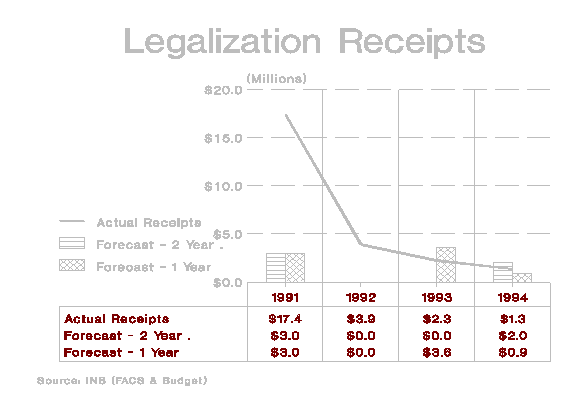
Because this program is phasing out, we agree with INS' decision
not to expend additional resources in developing more
sophisticated forecast methods. However, if the class action suit
or other movements result in the reopening of the Legalization
Program, we encourage INS to adopt techniques and recommendations
that were discussed in other sections of this report. We
particularly advocate the use of working groups or teams to
evaluate relevant factors.
The INS officials also stated that there was some movement
toward merging what remains of the Legalization Fee Account into
the Examinations Fee Account. We agree that would be appropriate
at this time.
LAND BORDER FEE
An appropriate forecast method for the Land Border Fee had not
been developed. Revenue estimates were not adjusted to reflect
variances in population size, density, or port usage. In
addition, available information on decal sales and inspection
workload were not always used in preparing revenue forecasts.
Additional U.S. land border sites along the northern border, and
at least one on the southern border, will be opening. As the Land
Border Fee Account grows, the lack of an appropriate forecast
method and inadequate fund monitoring practices, could become
critical.
The Land Border Inspection Fee Account was established as a
pilot program [ This pilot program will expire September 30,
1996, unless extended.] by the DOJ Appropriation Act of 1991,
P.L. 101-515. This Act authorized the Attorney General to
establish, by regulation, pilot projects under which fees may be
charged at one or more land border ports of entry to study the
feasibility of charging fees to provide inspection services at
land border ports of entry. Collections from this program were
restricted to improving or developing traffic facilitation and
inspections techniques. Program managers use funds for operating
expenses at the test sites and excess funds are used to develop
new border control techniques. The fees collected under this Act
were deposited into a separate account.
Prior to FY 1996, INS was operating Land Border Fee sites at
Blaine, Washington; Point Roberts, Washington; and Detroit,
Michigan. At these sites, applicants were charged $25 per vehicle
to obtain a decal that permits use of a traffic lane dedicated to
commuters and frequent crossers. Vehicles using the commuter lane
were defined by INS as low risk frequent crossers. This
population represented an average of 23 percent of the total
vehicle traffic processed annually at the Blaine, Washington
site. Applicants for the decals paid in person or mailed
applications to the participating land border site. Receipts were
collected, totaled, and sent by INS employees to banks on a
regular basis. The INS opened the first dedicated commuter lane
on the southern border in the first quarter of FY 1996 at Otay
Mesa, California.
The INS also developed a program to facilitate the entry of
pre-screened local border residents through selected Northern
border ports of entry during periods when the port is closed to
general traffic. The Automated Permit Port program was designed
to allow entry by means of an automated access system. The
program would be utilized at low-volume, limited-hour, low risk
locations on the Northern border, using different forms of
automated technology (such as voice verification systems, video
inspections systems, card access systems, hand geometry, or other
forms of biometrics) depending on specific location requirements.
INS had planned to open several automated sites in late FY 1995
on the Northern border, and several more sites in FY 1996.
Although none were opened in FY 1995, several began opening
during FY 1996.
Some program managers in the land border inspection program
receive weekly activity reports from the dedicated commuter lane
ports that show the number of inspections performed, and the
number of decals sold and issued. These weekly activity reports
appeared to be timely and accurate. Our comparisons of data
contained in these weekly reports and the Performance Analysis
System monthly reports indicated that the two sources were
consistent. We also compared monthly deposit totals in the
Financial Accounting and Control System (FACS) for the Land
Border Fee Account to bank deposit records at one dedicated
commuter lane site and found significant inconsistences at one
site. These differences resulted from delays in entering deposit
information into FACS. As a result, management did not always
know on a timely basis how much revenue was available in this
fund balance. However, INS did not use either the weekly activity
report or the Performance Analysis System monthly report on a
regular basis to evaluate land border workload activity or
forecast revenue.
Forecast Effectiveness
The chart below shows INS estimates over this period. When the
pilot program began, INS management anticipated revenues of $1
million per site, per annum. A revenue over forecast of nearly
$3.4 million resulted, in FY 1993.
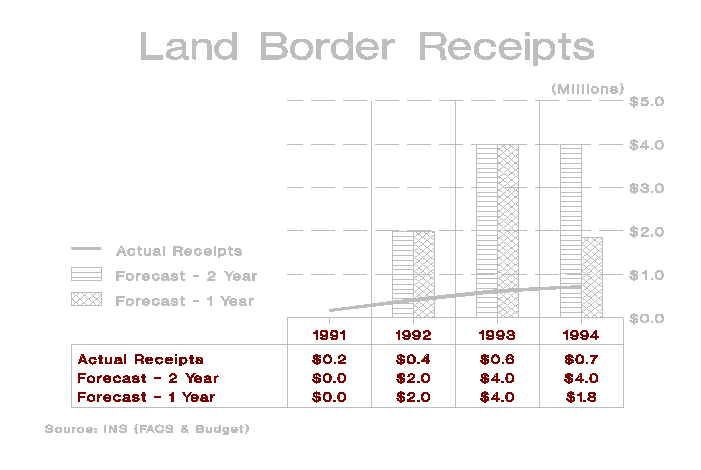
Since the land border program began, there have been delays in
opening new sites and in FY 1994 estimates were adjusted
accordingly.
While the Land Border Fee program is not a major program that
generates a substantial amount of fee revenue, the INS intends to
significantly expand the number of sites using dedicated commuter
lanes and automated ports. With expansion, actual receipts will
grow and inexact revenue forecasts will become more serious.
Relevant factors should be evaluated when estimating revenue for
future ports, such as size of the local population, historical
records of the number of weekly border crossings, and the average
time for each vehicle to pass through the inspection point. The
documentation and analysis of this type of information should
lead to more realistic and accurate revenue forecasts.
We found that land border receipt activity was not collected
and evaluated regularly by INS. INS staff in both program
operations and budget indicated that other offices were
responsible for monitoring the collection of fee receipts. Such
ambiguities could become significant as the size of the land
border account grows. Responsibilities between offices and staff
members need to be more clearly defined so that information is
available without duplication or omission. The use of a working
group or team appears particularly appropriate for refining Land
Border Fee revenue estimates.
RECOMMENDATION
We recommend that the INS Commissioner:
6. Direct program managers, budget analysts, and accountants
to share information and develop taskings for monitoring activity
and identifying key evaluation factors.
Immigration and Naturalization Service Comments
INS agrees. A memorandum is being prepared for the Deputy
Commissioner's signature to formalize these working groups,
including one for the Land Border Fee Account. These issues are
to be included in the scope of the working group's activities.
Status of Recommendation
Resolved, based on INS' issuance of the memorandum discussed
above formalizing working groups for each of the Fee Accounts. To
close this recommendation, please provide a copy of the final
objectives and requirements developed for each working group.
#####






